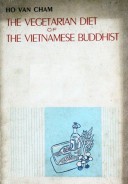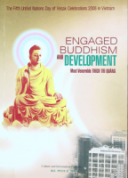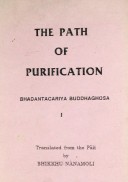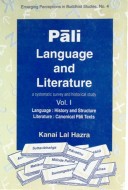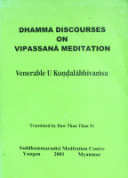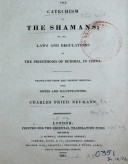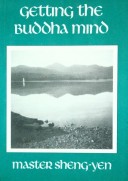Tìm Sách
Sách tiếng Anh-English >> Buddhism In China
Thông tin tra cứu
- Tên sách : Buddhism In China
- Tác giả : Chao Pu-chu
- Dịch giả :
- Ngôn ngữ : Anh
- Số trang : 55
- Nhà xuất bản : The Chinese Buddhist Association Peking
- Năm xuất bản : 1957
- Phân loại : Sách tiếng Anh-English
- MCB : 12100000002568
- OPAC :
- Tóm tắt :
Buddhism In China
by Chao Pu-chu
Vice-President and General Secretary of the Buddhist Association of China
The Chinese Buddhist Association Peking 1957
Printed in the People’s Republic of China
I. OUR GRATITUDE
Buddhists should always cherish a feeling of gratitude. Our object of gratitude is not god, but man.
We are grateful to men and to the lands in which they live. Therefore in our morning and evening services, we Chinese Buddhists vow to repay the benefaction of the lands in which men live and of all living beings.
As a Chinese citizen and a Chinese Buddhist, I should of course be grateful to my country and my people, I should of course be grateful to our great present and glorious past, and I should of course be grateful to Fa-hsien and Hsuan-tsang. At the same time, I am grateful to India and the Indians, to Nepal and the Nepalese, to the Western Regions and some of the South-east Asian countries and the peoples of these countries from whom we accepted the faith of Buddhism and absorbed Buddhist culture.
To look back over our history is helpful for our friendship and co-operation today. I wish, therefore, to give a brief account of the historical facts concerning the introduction of Buddhism into China and its development in China.
Two years before the Christian era Yi-chen, an envoy of the King of the Yueh-chi, arrived in Changan (modern Sian) which was then the capital of China.
He taught a Buddhist scripture orally to Ching Lu, a scholar of the Imperial Academy. This is the earliest record in Chinese history of the introduction of Buddhism into China. We may infer from this the possibility that Buddhism which ' had already been introduced into Central Asia from India, spread to the east with travellers as a result of the opening of communications with the Western Regions by Emperor Wu (141-87 B.C.) of the Han dynasty some 120 years prior to that event. There is also a tradition that during the reign of the First Emperor of the Chin dynasty, a contemporary of King Asoka of India, sonje Indian sramanasarrived in China.* But the generally acknowledged inception of Buddhism in China was 66 years after thé arrival of Yi-chen, when it is said that Emperor Ming (A.D. 57-75) of the Han dynasty sent a mission of twelve persons to the Western Regions to seek for Buddhism. In A.D. 67 they returned with two Indian monks, Kasyapa-Matanga and Dhar- maranya, bringing with them some Buddhist scriptures and images of the Buddha. They started the translation of Buddhist scriptures into Chinese, and it is said that the existing Sutra of Forty-two Chapters,an excerpt of the Agamas,was translated by them. At the same time the first Buddhist monastery in China was built at Loyang, the then capital of China. This was
•According to an ancient tradition, a group of eighteen foreign monks, Shih-li-fang and others, arrived in China with some Buddhist scriptures during the reign of the First Emperor of the Chin dynasty. Being imprisoned by the emperor, they were set free in the night by a golden figure of sixteen feet tall who broke the prison and rescued them.
the White Horse Monastery, which is still in existence. It is said that the name of this monastery was derived from the fact that the Buddhist scriptures and images of the Buddha were carried into China on a white horse. Based on this tradition we may consider that Buddhism was not first introduced into China during the reign of Emperor Ming of the Han dynasty, but that its foundations as a religion, acknowledged and supported by the government, were already established in China in that period.*
China had Buddhist monks at a very early date, but the first monks only, renounced their homes, shaved their heads and lived under the guidance of a teacher in accordance with the Vinaya rules, without a system of ordination. In A.D. 250 when Dharmakara, a monk of Central India, came to China and founded the ordination altar in the White Horse Monastery at Loyang for the formal ordination of Chinese monks, China began to have properly ordained Bhiksus. As there were no foreign Bhiksunis in China, the first Chinese women who renounced their homes to become Buddhist nuns only received their ordination from the Bhiksus, without a complete system of ordination for Buddhist nuns. In A.D. 429 and 433 when nineteen
•According to Chinese chronicles, Prince Ying of Chu, a younger brother of Emperor Ming of the Han dynasty, was a Buddhist follower, whose offerings to Emperor Ming were returned to him, by order of the emperor, to help maintain the monks. This occurred before the coming of Kasyapa- Matanga and Dharmaranya. It shows that Buddhism had long been the adopted religion in the royal family at that time.Buddhist nuns, Devasara and the others, came to China from Ceylon in different groups, Chinese Buddhist nuns were able to have the complete conditions required for Bhiksunis’ full ordination, and China began to have properly ordained Bhiksunis*
The spread of Buddhism in China was inseparable from the task of translating Buddhist scriptures into Chinese. Among the first translators during the 2nd and 3rd centuries A.D., we must mention the names of An-shih-kao of Parthia.** Lokaksin of Indo-
*In A.D. 429, eight Bhiksunis came from Ceylon to Nanking, in Nandi's ship, and stayed in the Ching Fu Nunnery. Hui-kuo and some other nuns of the nunnery wished to receive re-ordination from them (for Bhiksunis should receive their ordination from both Bhiksus and Bhiksunis). But Gunavarman who was then preaching Buddhism at Nanking, ruled that those Bhiksunis had not been in the order long enough to give an ordination and they fell short of the number of ten persons required, so the ordination did not take place. (At least ten persons are required to conduct the ordination ceremony and they should have been in the order for more than ten years.) In A.D. 433, Nandi brought another group of eleven Bhiksunis, Devasara and others, from Ceylon to China. By this time the Bhiksunis who arrived earlier had mastered the Chinese language, and so an ordination altar was erected in the Nan Ling Monastery, and more than 300 Chinese Bhiksunis received, at different times, their ordination afresh.
**Parthia was an ancient kingdom which existed from 250 B.C. to the 3rd century A.D., and its domain included modern Iran and a part of Soviet Central Asia. An-shih-kao was a prince of Parthia.
Scythia, Sangnavarman and Sanghapala of Soghdiana,* and Dharmaraksa who was the first Chinese monk of Indo-Scythian descent who travelled to the West to seek for Buddhism. Due to their efforts many Srava- kayana and Mahayana scriptures were translated into the Han language. As translation work was in its infancy, conditions were limited and translation was not carried out in a planned and systematic way. Few of the works were full translations and no fixed style of translation could be established. But they carried out the task of opening up the field in a distinguished manner, founded a position for Buddhism among thinking Chinese people and enlarged its influence.
The prevalence of Buddhism in China started from the 4th century A.D. The Ven. Tao-an of that time was a man of great importance. He was the first enthusiastic Buddhist preacher of China and he sent his disciples to various places to propagate Buddhism. He was the first founder of the system of Sangha in China. He searched assiduously for Vinaya books, in order to make the incomplete Vinaya-pitaka of his days complete, and instituted a monastic system which all the monks and nuns of his time adopted. (It was Tao-an who initiated the custom that the Chinese monks abolish their original surnames after renouncing their homes and assume the new surname of “Shih”
Soghdiana was a kingdom prior, to the 6th century A.D. in what is now the Kirghiz S.S.R. and Kazakh S.S.R.
for Sakya.)* He arranged all the translated scriptures and compiled the first catalogue of Chinese Bud- dhist canons. He did everything to encourage ‘translation and summed up, for the first time, all the experiences in translating Buddhist scriptures. Under his guidance many Buddhist scriptures were translated, and he assembled and educated many scholars and translators, thus providing favourable conditions for the large-scale translation of Kumarajiva of a later time.
The enthusiasm of Tao-an and his disciples in looking for Vinaya books gave great impetus to the completion of the Vinaya-pitaka. During his lifetime, Tao- an obtained a large quantity of Vinaya books and translated a part of them. It is regretted that these books were lost. Not long afterwards, Punyatara and Dhar- maruci came from Kashmira and helped Kumarajiva,**
[1]In the beginning the Chinese monks adopted the surnames of their masters, but Tao-an (312-385) advocated that they should adopt the surname of the Founder of Buddhism and so the word “Shih” was used as his surname. Afterwards the Ekottarikagamawas translated into Chinese, and the passage “When the four rivers have flowed to the sea, they will lose their original names, and in the same way when people of the four castes have become monks, they will be called as the clan of Sakya,” proved his suggestion to be correct. From then on, “Shih” became the surname of all Chinese monks.
**Kumarajiva (343-413) Was born in Kucha (modern Kucha County in Sinkiang Uighur Autonomous Region). He was the son of the princess of Kucha and his father was an Indian noble. In A. D. 401 Yao Hsin, the lord of Chin, invited him to Changan to translate Buddhist scriptures, and two to three thousand well-qualified Buddhist scholars of the time were assembled to help him with the task.
at different times, in translating the Sarvastivadin Vinaya,which was widely popularized south of the Yangtse River by Kumarajiva’s teacher, Vimalaksa. Buddhayasa (another Kashmirian) translated the Dfuir- magupta Vinayain A.D. 410. Sanghabhadra who came to China by the instruction of Buddhaghosa, translated the Sudarsana-vinaya-vibhasa.It was chiefly for the purpose of seeking for Vinaya books that the Ven. Fa-hsien travelled to India at the beginning of the 5th century A.D. It is known to all that the Ven. Fa-hsien was a great seeker after Buddhism. His travels and his other achievements may have possibly overshadowed his primary objective of seeking out Vinaya books and his achievements in this respect. Besides bringing back many Buddhist scriptures, he also brought back with him the Mahasanghikah Vinaya and the Mahisasakah Vinaya,the former book being jointly translated by him and Buddhabhadra of Kapi- lavastu (in modern Nepal), and the latter translated after his death by Buddhajiva of Kashmira# The Ven. Yi-ching of the 7th century A.D., another seeker after Buddhism, also travelled abroad with the ambition of finding Vinaya books. He brought back with him and translated eleven works of the Sarvastivadin school and made the Vinaya-pitaka more complete than before. Therefore, we have in the Chinese translations of the Vinaya-pitaka the Dharmagupta Vinayain 67 volumes, the Sarvastivadin Vinayain 157 volumes, the Dasadhyaya Vinayain 61 volumes, the Mahasanghikah Vinayain 40 volumes and the Mahisasakah Vinayain 30 volumes. There are altogether about 500 volumesincluding the Karmans and Pratimoksas and commentaries in exposition of the Vinaya-pitaka, and more than 500 volumes of works concerning the Vinaya- pitaka written by learned Chinese monks of later times. As regards the tradition of the Vtnaya° of Chinese Bhiksus, the Dharmagupta Vinayais usually followed by the Han nationality, while in the regions in which the Tibetan system of Buddhism is prevalent, the Sarvastivadin Vinayahas been adopted. In the area of the Tai nationality the Theravadin Vinaya is followed. This belongs to the same school as the Dharmagupta Vinaya and it is the same as the Vinaya prevalent in Ceylon and Burma and some other countries.
The large-scale and systematic translation of Buddhist scriptures and commentaries was started by Kumarajiva in the 5th century A.D. He had one advantage which his predecessors never enjoyed, support from the government. But his great achievements were due ohiefly to his rich knowledge and persistent efforts. He and the Ven. Hsuan-tsang of a later time were two great masters of translation. His translations of more than 400 volumes are not only a Buddhist treasury, they are also a priceless legacy of literature. His influence upon Chinese thought and literature was very great. He. educated thousands of persons, instructing and guiding them, and thus greatly elevating and developing Buddhism in his time. Kumarajiva’s most important contribution to Buddhism was his introduction of the Madhyamika system of Buddhism of India. It was owing to his efforts that the importantworks of the Madhyamika school, such as the Mad- hyamika-sastra,the Sata-sastrathe Dvadasanikaya- sastraand the Mahaprajna-paramita-sutraand its commentary the Mahaprajna-paramita-sastra,were translated into Chinese. Thus he laid a broad foundation for the Dharmata school in China.
Not long after the time of Kumarajiva, Paramartha, an Indian Buddhist scholar, came to China from the Kingdom of Fu-nan (in modern Cambodia) at the invitation of Emperor Wu (A.D. 502-549) of the Liang dynasty. With the assistance of the King of Fu-nan, he brought to China a large shipment of Sanskrit Buddhist scriptures. Unfortunately, a war broke out in China after his arrival and, in the disturbed conditions he was unable to carry on translation work on a large scale. However, he managed to complete his translation of more than one hundred volumes of important works, that is, from the Abhidharma-kosa-sastrato the works of the Vijnanavada school of the Yogacara system of Buddhism in India. As one of the three great translators, the other two being Kumarajiva and Hsuan-tsang, Paramartha was the most important person in the first period of the introduction of the Yogacara system of Buddhism. Due to his translation and propagation, the studies of the Dharmalaksana school in China began to prosper, and as not many of the books of this system were translated and the theories were incomplete, it gave a motive to the Ven. Hsuan- tsang of a later time to travel to India to make a deeper study.So famous is the Ven. Hsuan-tsang that no detailed introduction of him is needed. He was a great traveller. He travelled alone in foreign countries for seventeen years and covered a distance of 50,000 li, leaving his imprint in the Western Regions and India. • He has left us a book of enduring value about his travels. Being a great scholar, well-learned in both Chinese and Indian literature, and well-versed in the teachings of the Tripitaka, he rose from his position as a student to that of a lecturer in the Nalanda Monastery which was then the most important centre of learning in India. He was welcomed and respected by kings and people, including monks and laymen, of many countries. He devoted himself to the work of cultural exchange between China and India, and translated 1,335 volumes of Sanskrit scriptures and commentaries into Chinese. His precise and scrupulous system for translation and his sedulous manner of work set a splendid example in the history of translation in China. His great achievements and contributions were not only in the field of Buddhism, but in learning and culture as well. Thanks to his efforts (and of course thanks to his teacher the Ven. Silabhadra) the Yogacara system of Buddhism has been completely and brilliantly established in China.
Translation work among the Han nationality in China continued over ten centuries. More than 1,400 books, in more than 4,700 volumes, of Sutra, Vinaya and Abhidharma, have been translated into Chinese. There were no less than 200 well-known Chinese and foreign translators. Besides the trans-lators we have mentioned above, Dharmaraksa of India, Jnanagupta and Danapala of Pakistan, Prajna of Afghanistan, Mandala and Sanghapala of Cambodia, are well-known. Through such persistent labours, the Sravakayana and the Bodhisattvayana of Buddhism and the Buddhist theories of the Dharmata and the Dharmalaksana, the esoteric and exoteric schools have all been introduced into China, forming a great treasury of Buddhism. In the All-China Literary and Translation Workers’ Conference held in 1954, Mao Tun, Chairman of the Chinese Writers’ Union, said in his report: “Translation work in China has a long history and a glorious tradition. The scrupulous and scientific methods established by our ancestors in translating Buddhist scriptures and their excellent achievements are worthy of our pride and are good examples for us.”*
The Tibetan system of Buddhism in China had its beginning in the middle of the 7th century A.D. Under the influence of his two wives, Princess Wen-chen of
[1]In ancient times the translation of Buddhist scriptures followed a fairly strict system. As a rule the translation of a scripture had to go through the careful and repeated collation of such persons as the chief translator, the scribe, the literary polisher, the text collator and the general editor, so as to produce a correct translation with regard both to sound and meaning. As to the method of translation, the rule of “five kinds of terms which are not to be translated” laid down by the Ven. Hsuan-tsang, set a standard for translation and transliteration, and his method of the six interpretations of compound terms fixed the rule governing definition. To a modern translator, all these will serve as useful reference.
the Tang dynasty and Princess Bhrkuti of Nepal, Srongtsan Gambo, the King of Tibet of that period* accepted the Buddhist faith. He sent a mission of sixteen persons, headed by his minister Tumesambazha, to India to learn Sanskrit and Buddhist scriptures. On their return, they created the Tibetan alphabet and translated some Buddhist scriptures into the Tibetan language. In the 8th century A.D., Padma- sambhava went to Tibet from India, subdued the “bon” religion which was then prevalent in Tibet, and propagated Buddhism. During the 10th century, Buddhism was persecuted in Tibet. Then Atisha, a learned Indian monk, came to Tibet during the 11th century and revived it. At the same time some Tibetan monks, Rinchen-zanbo and others, translated more scriptures and commentaries into the Tibetan language. After that many Indian scholars, especially the scholars of Nalanda, came to Tibet during troublous times in India; thus translation work flourished greatly. Most of the books of the Tibetan Tripitaka, more than 4,500 in number, were directly translated from the Sanskrit, while a few of them were re-translated from the Han language. Therefore, a very big proportion of Indian Buddhist works of the later period have been preserved in the Tibetan Tripitaka. Up to the present time the five courses of Hetuvidya, Abhidharma-kosa, Vinaya, Madhyamika and Yogacara are the principal curricula taught in the chief monasteries in Tibet. According to the records of Hsuan-tsang and Yi-ching, we may see that the tradition and style of study of the ancient Nalanda Monastery are still observed in Tibet.
Kuang Chi Monastery at Peking, the seat of the Chinese Buddhist Association
White Horse Monasty, Loyang, Honan Province. Originally built around A.D. 58-75, during the Eastern Han dynasty, it is China’s earliest Buddhist temple extant
Tzu En Monastery (built A.D. 648) and the Wild Goose Pagoda (built in 652) at Sian, where the Venerable Hsuan-tsang translated Buddhist scriptures during the Tang dynasty (618-907)
The 90-metre-high, 9-storied, octagonal Flower Pagoda of the Lu Yung Monastery at Canton., First erected in A.D. 537, it was rebuilt In 1086
H s u a n - tsang translating Buddhist scriptures, a woodcut of the early Ming dynasty (14th century)
Preaching Buddha mural in the Thousand Buddha Cave at Pairheng. Sin- kiang Uighur Autonomous Region
I.ochana Buddha (extreme left) and attendants at the Feng Hsicn Temple. Lungmcn. near Loyang. The 17-metre-high figure was carved during the years A.D. 672-675
Bodhidharma figure in the Shao Lin Monastery at Sungshan, Honan Province
The Pali system of Buddhism (Theravadin Buddhism) is prevalent in the region of the Tai nationality in Yunnan Province. The customs and habits of the people there are roughly the same as those in the southern Buddhist countries. As they read the Pali Canons, they have no need to translate them, but their efforts in propagating and studying the Dharma during the past several hundred years are worthy of our praise.
From the above brief account we may see how our ancestors—both Chinese and of other countries—strove together for a common great aim. Without any preconception or biased opinion, but for loyalty to truth and for compassion for all mankind of ail races, they overcame innumerable hardships, suffered cold and hunger, crossed deserts and snow mountains, or sailed over great seas at the risk of their lives to reach their destinations. Many of them died on the way. We cannot but have a feeling of boundless respect and gratitude for them, when we remember their lofty ambition and deeds; when we mention their names or when we read their biographies.
II. OUR ACHIEVEMENTS IN THE PAST
The achievements of Buddhism in China may be classified into:
1. The rise of different sects and schools.
With the introduction of Buddhist scriptures and commentaries in large numbers, the thoughts of dif-ferent Buddhist schools in India came in contact with the national cultures of China, and after a long period of absorption and assimilation, they had a creative development in China. The Sui and Tang periods, from the end of the 6th century to the middle of the 9th century A.D., were the golden age of Buddhism in China. During these periods the different schools and sects emerged one after the other, reaching a brilliant and flourishing state.
The “Tri-sastra” sect was formed on the studies of the Madhyamika-sastra,the Sata-saslraand the Dvadasanikaya-sastra,which were translated by Kumarajiva. The theory of this sect is to disclose the unreality of all Dharmas of the five Skandhas through the realization of true voidness, and to destroy completely the delusions of the “three evils,” so as to establish the right conception of Middle Path in which everything is non-existent. This sect is in fact a branch of the Indian Madhyamika system, and it was the direct successor to the theories of Nagarjuna and Deva.
The Dharmalaksana sect was formed on the studies of the Sandhinirmocana-sutra,the Yogacarya-bhumi- sastraand the Vijnaptimatrata-siddhi-sastra,which were translated by Hsuan-tsang. The theory of this sect is to give a wide analysis of the nature and phenomenon of all Dharmas in exposition of the causal and conditional nature and function of all things, and to practise the contemplation of Vijnaptimatra. This sect is, in fact, a branch of the Yogacara system and the direct successor to the theories of Asanga and Vasubandhu.
We have the Tien Tai sect and the Avatamsaka sect, which, taking the Indian scriptures and com- mentarles as their basis, systematically organized and developed the teachings of the Buddha. The most important person of the Tien Tai sect was the Ven. Chih- yi of the 6th century A.D. He summed up all the theories of the different schools, accurately organized the Buddhist teachings, developed the thoughts of complete and immediate teachings of Mahay ana Buddhism, and formed a complete system of theoretical study and practical meditation. Of the Avatamsaka sect the most important person was the Ven. Hsien-shou who lived between the 7th and the 8th centuries A.D. Taking the teachings of the Avatamsaka-sutraas its basis, this sect emphatically expounded the theory of the conditional rising of the Dharmadhatu and the methods of practical meditation.
In the studies of Dhyana, China has a specific school, namely, the Chan school, which is said to be an intuitive school that does not depend on texts and canons. What is practised by this school is not the traditional “gradual meditation” (catur-dhyana), but an immediate Way by which one obtains a direct and instant realization of the nature of mind. It is said that the methods of meditation of this school were brought to China from India by Bodhidharma in the 5th century, and were popularized by Hui-neng, the Sixth Patriarch, between the 7th and the 8th centuries. Since the 11th century this school and the Pure Land school have been the two most prevalent Buddhist schools in China.Because it is easy to practise and acceptable to the masses, the Pure Land school has a special development in China. This is a school founded upon the teachings of the Sukhavati-vyuha-sutraand some other sutras, which promote the meditation'and recitation of Amitabha Buddha, so that one may be reborn to the Pure Land. The Ven. Hui-yuan of the 5th century was the founder of this school, and the Ven. Tan-luan of the 6th century and the Ven. Shan-tao of the 7th century were the important propagators of this school.
The Vinaya school was founded in China upon the expositions of the Caturvarga Vinayaof the Dharma- gupta school according to Mahayana teachings. The important person of this school was the Ven. Tao- hsuan, a contemporary of the Ven. Hsuan-tsang. It is owing to the prevalence of this school that in the practice of the three Mahayanist learnings—Sila, Samadhi and Prajna—the Chinese Buddhist monks also lay emphasis on the practice of the obsei vance of good deeds and the prevention of committing the rules according to the Theravadin Vinaya.
During the 8th century the Tantric teachings of the Yogacara system of India were introduced into China by Subhakarasinha, Vajrabodhi, Amoghavajra and others, and they gave rise to the Tantric school in China.
These are the eight principal schools of the Han language system of Buddhism in China. There have been also the Abhidharma-kosa school for the exclusive study of the Abhidharma-kosa-sastra,theSatyasiddhischool which had the Satyasiddhi-sastraas its chief text for study, and the different schools for the study of the Mahay ana-samparigrahasastra, the Dasab- humikasutra-sastraand the Mahaparinirvana-sutra. All these schools existed at one time, but they were short-lived and were either lost in oblivion or have been absorbed into other schools.
In the Tibetan system of Buddhism, there have also emerged different schools and sects. Owing to the prevalence of doctrinal preaching and theoretical debating, each of the schools — the Rnin-ma-pa, the Jo- nan-pa, the Shi-bged-pa, the Gcod-yul-pa, and the Sha- lu-pa — has its particular teachings and methods of mental cultivation. The Dge-lugs-pa sect was founded by the Ven. Tson-kha-pa in the 15th century in succession to the achievements of his predecessors. He rearranged and developed the Buddhist doctrines and reorganized the system of Sangha. This is the most prevalent sect at present in the Tibetan and Mongolian regions in China.
In the Pali system of Buddhism in China, there are also different sects, but these sects only vary in some degree in the observance of the Vinaya rules and they are not sects of doctrinal differences.
Through wide study and propagation, the theories of the different schools of Buddhism in China had a great influence upon thinking people. For instance, the Confucian metaphysical and moral philosophy of the Sung and Ming dynasties was apparently produced to a large extent under the stimulation and influence of the teachings of the Chan school and other Buddhistdoctrines. During the later part of the Ching dynasty, there was a general tendency for Chinese intellectuals to study Buddhism. Some of the pioneers of the movement for democratic thought, such as Tan Ssu-tung, Kang Yu-wei, Liang Chi-chao,* Chang Tai-yea** and others, adopted one part or other of Buddhist doctrines as their weapons of thought. The Buddhist concept of equality, compassion, impermanence and non-ego was an enlightening and encouraging influence among Chinese intellectuals of those days.
Yang Jen-shan (1837-1911) was a promoter of the study of Buddhism in modern times. For the education of Buddhist scholars and for the wide circulation of Buddhist books for the convenience of Buddhist students, he spent several decades in giving lectures on Buddhism and engraving wooden blocks for the printing of Buddhist books. The Ching Ling Buddhist Text Society, which was founded by him, published the important works of the Dharmalaksana school which were lost in China and were brought back from Japan, and thus revived the study of the Dharmalaksana school in
•Tan Ssu-tung (1865-1898), Kang Yu-wei (1858-1927) and Liang Chi-chao (1873-1929) were the leading figures of the Wu Hsi (1898) Movement of Political Reforms, and Tan Ssu-tung was the most radical one in the movement. Hç wrote a book on .humanity, in which many Buddhist theories were quoted.
♦•Chang Tai-yen (1866-1936) was a famous Chinese scholar of modem times. He was one of the leaders of the Tung Meng Hui and took active part in the national revolutionary movement during his early years.
China. The Ching Ling Buddhist Text Society was also the place where he gave his lectures on Buddhism, and Tan Ssu-tung and Chang Tai-yen attended his lectures at that place. Under his influence a number of Buddhist scholars emerged, of whom Ouyang Ching-wu was a prominent scholar who was an expert of the Dharmalaksana school. He founded the China Inner Knowledge Institute at Nanking, which became the centre for the study of the Dharmalaksana school in his days. In north China we had Han Ching-chin of the Shan Shih Buddhist Institute, who was a scholar as famous as Ouyang Ching-wu and a promoter of the study of the Dharmalaksana school.
Among the prominent monks of modern times, we had Ven. Yueh-hsia, Ven. Ti-hsien, Ven. Ying- kuang, Ven. Hung-yi and others, who propagated the Avatamsaka school, the Tien Tai school, the Pure Land school and the Vinaya school respectively. The Ven. Tai-hsu who died ten years ago, was a man who exerted his utmost efforts for the promotion of monks’ education and was a learned Buddhist activist. His efforts in those dark days for Buddhism are worthy of our remembrance.
2. Influence on culture and art.
Several thousand volumes of scriptures translated from Sanskrit are in themselves a great treasury of literature. Among them the Virnalakirti-nirdesa- sutra,the Saddharma-pundarika-sutraand the Su- rangama-sutrahave been held precious by men of letters of different ages and have been studied purely for literary purposes. Lu Hsun, the great modem
 Facebook
Facebook
 Google
Google
 Google+
Google+


